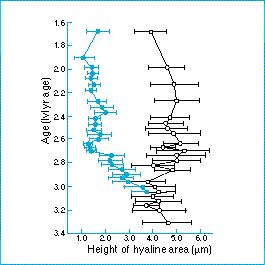The evidence for evolution - What evidence does the fossil record provide?

Diatoms
Diatoms are single-celled, photosynthetic organisms that float in the plankton. Many species grow beautiful glasslike cell walls, and these can be preserved as fossils. The figure illustrates the fossil record for the diatom Rhizosolenia between 3.3 and 1.6 million years ago. About 3 million years ago, a single ancestral species split into two; and there is a comprehensive fossil record of the change at the time of the split.
The diatoms show that the fossil record can be complete enough to reveal the origin of a new species. Examples as good as this are rare: in other cases, the fossil record is less complete and there are large gaps between successive samples.
In other respects, the fossil record is valuable because it shows that the living world has not always been like it is now. The existence alone of fossils shows that there has been some kind of change, though it does not have to have been change in the sense of descent with modification.
Figure: evolution of the diatom Rhizosolenia. The form of the diatom is measured by the height of hyaline (glasslike) area of the cell wall. 0-0 indicate forms classified as R. praebergonii, •-• indicate R. bergonii. Bars indicate the range of forms at each time. From Cronin & Schneider (1990)
| Next |



